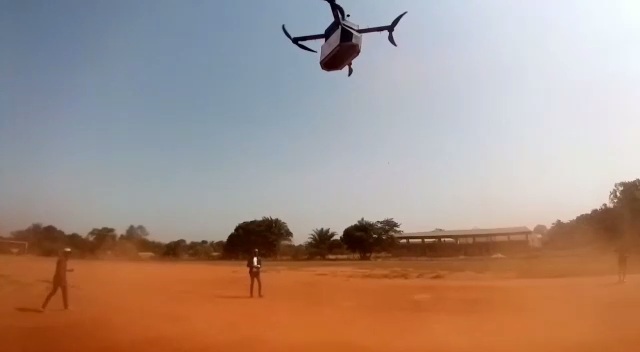Drones are gaining more popularity by the day for the logistics solutions that they provide. Also known as unmanned aerial vehicles (UAVs), drones overcome transport delays to facilitate high-speed delivery of items including emergency medical supplies, vaccines and even online shopping orders.
As part of global COVID-19 response strategies, drones are being leveraged to deliver COVID-19 vaccines to target locations such as clinics and hospitals in a matter of minutes. By offering superfast deliveries, drones have helped cut costs associated with the cold storage of these vaccines.
Meet Emmanuel Ezenwere
Emmanuel is the CEO and founder of Arone Aerial Logistics Nigeria. He is an inventor, programmer, artificial intelligence (AI) engineer and serial entrepreneur. His areas of expertise include building autonomous navigation technology for drones, computer vision, AI and sensor fusion technologies.


Before founding Arone in 2018, Emmanuel briefly worked as a Computer Vision Engineer at MagicMirror.ai in Enugu, Nigeria.
At Arone, Emmanuel leads the team building aerial logistics solutions to make last mile delivery across Africa quicker, ecofriendly and more affordable through its fleet of autonomous delivery drones and a decentralized network of Arone stations.
Arone won N3 million in funding for emerging runner-up in the National UAV competition held in Kaduna last year December.
Q. Drone startups are still nascent in Nigeria and many people don’t really understand how drones work. What are the technologies powering a drone?
Of the many technologies include:
- Complex control algorithms that enable drones fly and stabilize them during flight against external forces eg. wind, gravity.
- Energy storage and power generation technologies; batteries for battery-powered drones, internal combustion engines for gasoline-powered drones and fuel cells for hydrogen-powered drones.
- Telecommunication technologies which could be radio frequency-based or Wi-Fi based.
Q. People might have privacy concerns due to the surveillance nature of drones. How would this be addressed?
This depends on the application of the drone. For a surveillance drone whose primary mission is to collect videos or multi-spectral data, privacy concerns are unavoidable.
For non-surveillance drones flying over residential areas, flying at a “high enough” altitude or having onboard cameras that point away during flight should suffice.
From a legal standpoint, some countries define the civil airspace as above 200 feet. So as a homeowner, there’s little you can do if a drone flies above that altitude.
Q. In your own estimation, how many COVID-19 supplies can the typical drone deliver in a day based on distance and speed of travel?
Interestingly we made this calculation weeks ago. This will depend mostly on the payload capacity of the drone.


For our smallest size delivery drone with payload capacity of 5kg, we can transport between 2,500 to 25,000 vials (vaccine units) per flight and for our biggest drone, the Arone HeavyLift with a payload capacity of 20kg, we can transport between 4,000 to 100,000 per flight at recommended storage temperature.
In summary, our smallest delivery drone has the capacity to deliver all the vaccines needed in a typical vaccination center for a day in one flight. This brings an unprecedented level of efficiency in cost and speed to the distribution of vaccines.
Q. COVID-19 vaccines require cold storage, and we know that Nigeria is a high temperature region. Do flying drones have a temperature-adaptive system to ensure that vaccines remain cold pre-delivery? How would the vaccines be packaged?
Yes they do. There exist active and passive cooling systems that will be used in transporting these vaccines to ensure the vaccine stays within their temperature limits. During passive cooling, the vaccine vials are put in thermal boxes and jammed with dry ice.
Q. Cold weather and water are said to affect the drone sensors which may cause the drone to drift or be less responsive to control inputs. Are there systems in place to combat this in the case of rainfall during delivery?
The drone’s airframe (body) and propulsion systems are water-resistant and operable even at low temperatures.
Q. What is the farthest distance the average drone can cover? Are there speed limits?
The current Guinness World Record places the figure at 13,840km. This was done by the Global Hawk.


With current level of technological progress made in unmanned flight, there’s no limit. A solar powered drone with an appropriate battery/energy storage system can fly around the earth indefinitely.
On speed limits, from a physics standpoint, no. From an engineering perspective, yes. At supersonic speed levels, temperature, material strength and noise levels become very important considerations to make.
Q. What have been your biggest challenges so far in the drone delivery space and what solutions would you recommend?
It is capital intensive, so funding has been the biggest challenge. We have had to bootstrap through personal funding and financing from family and friends. But I’m glad we’ve made significant progress with our current pre-seed investment round.
I think the funding challenge is just part of the process. It helps you refine your solution till it becomes viable and attractive to investors.






